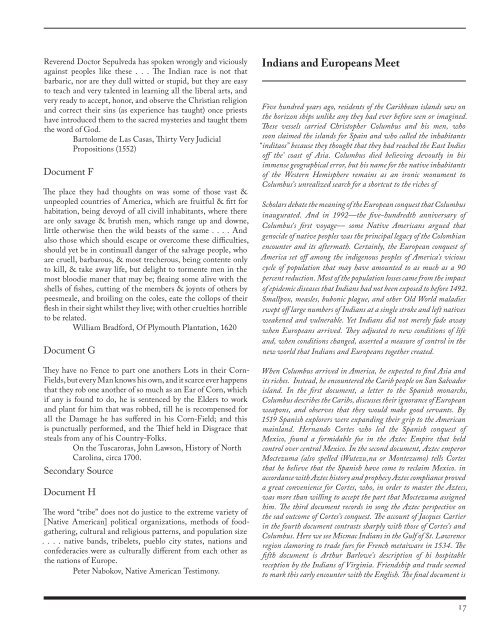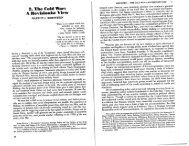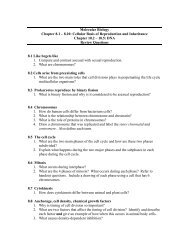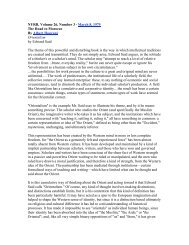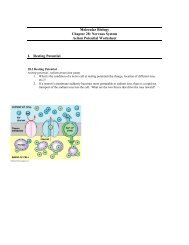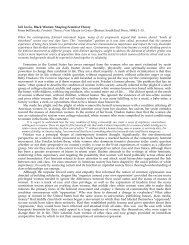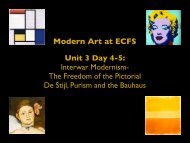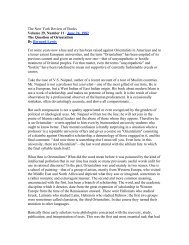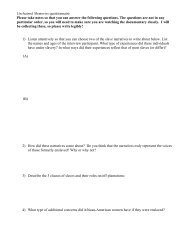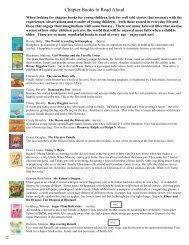fieldston american reader volume i â fall 2007 - Ethical Culture ...
fieldston american reader volume i â fall 2007 - Ethical Culture ...
fieldston american reader volume i â fall 2007 - Ethical Culture ...
- No tags were found...
Create successful ePaper yourself
Turn your PDF publications into a flip-book with our unique Google optimized e-Paper software.
Reverend Doctor Sepulveda has spoken wrongly and viciouslyagainst peoples like these . . . The Indian race is not thatbarbaric, nor are they dull witted or stupid, but they are easyto teach and very talented in learning all the liberal arts, andvery ready to accept, honor, and observe the Christian religionand correct their sins (as experience has taught) once priestshave introduced them to the sacred mysteries and taught themthe word of God.Bartolome de Las Casas, Thirty Very JudicialPropositions (1552)Document FThe place they had thoughts on was some of those vast &unpeopled countries of America, which are fruitful & fitt forhabitation, being devoyd of all civill inhabitants, where thereare only savage & brutish men, which range up and downe,little otherwise then the wild beasts of the same . . . . Andalso those which should escape or overcome these difficulties,should yet be in continuall danger of the salvage people, whoare cruell, barbarous, & most trecherous, being contente onlyto kill, & take away life, but delight to tormente men in themost bloodie maner that may be; fleaing some alive with theshells of fishes, cutting of the members & joynts of others bypeesmeale, and broiling on the coles, eate the collops of theirflesh in their sight whilst they live; with other cruelties horribleto be related.William Bradford, Of Plymouth Plantation, 1620Document GThey have no Fence to part one anothers Lots in their Corn-Fields, but every Man knows his own, and it scarce ever happensthat they rob one another of so much as an Ear of Corn, whichif any is found to do, he is sentenced by the Elders to workand plant for him that was robbed, till he is recompensed forall the Damage he has suffered in his Corn-Field; and thisis punctually performed, and the Thief held in Disgrace thatsteals from any of his Country-Folks.On the Tuscaroras, John Lawson, History of NorthCarolina, circa 1700.Secondary SourceDocument HThe word “tribe” does not do justice to the extreme variety of[Native American] political organizations, methods of foodgathering,cultural and religious patterns, and population size. . . . native bands, tribelets, pueblo city states, nations andconfederacies were as culturally different from each other asthe nations of Europe.Peter Nabokov, Native American Testimony.Indians and Europeans MeetFive hundred years ago, residents of the Caribbean islands saw onthe horizon ships unlike any they had ever before seen or imagined.These vessels carried Christopher Columbus and his men, whosoon claimed the islands for Spain and who called the inhabitants“inditaos” because they thought that they had reached the East Indiesoff the’ coast of Asia. Columbus died believing devoutly in hisimmense geographical error, but his name for the native inhabitantsof the Western Hemisphere remains as an ironic monument toColumbus’s unrealized search for a shortcut to the riches ofScholars debate the meaning of the European conquest that Columbusinaugurated. And in 1992—the five-hundredth anniversary ofColumbus‘s first voyage— some Native Americans argued thatgenocide of native peoples was the principal legacy of the Colombianencounter and its aftermath. Certainly, the European conquest ofAmerica set off among the indigenous peoples of America’s viciouscycle of population that may have amounted to as much as a 90percent reduction. Most of the population losses came from the impactof epidemic diseases that Indians had not been exposed to before 1492.Smallpox, measles, bubonic plague, and other Old World maladiesswept off large numbers of Indians at a single stroke and left nativesweakened and vulnerable. Yet Indians did not merely fade awaywhen Europeans arrived. They adjusted to new conditions of lifeand, when conditions changed, asserted a measure of control in thenew world that Indians and Europeans together created.When Columbus arrived in America, he expected to find Asia andits riches. Instead, he encountered the Carib people on San Salvadorisland. In the first document, a letter to the Spanish monarchs,Columbus describes the Caribs, discusses their ignorance of Europeanweapons, and observes that they would make good servants. By1519 Spanish explorers were expanding their grip to the Americanmainland. Hernando Cortes who led the Spanish conquest ofMexico, found a formidable foe in the Aztec Empire that heldcontrol over central Mexico. In the second document, Aztec emperorMoctezuma (also spelled iWutezu,na or Montezumo) tells Cortesthat he believe that the Spanish have come to reclaim Mexico. inaccordance with Aztec history and prophecy Aztec compliance proveda great convenience for Cortes, who, in order to master the Aztecs,was more than willing to accept the part that Moctezuma assignedhim. The third document records in song the Aztec perspective onthe sad outcome of Cortes’s conquest. The account of Jacques Cartierin the fourth document contrasts sharply with those of Cortes’s andColumbus. Here we see Micmac Indians in the Gulf of St. Lawrenceregion clamoring to trade furs for French metaiware in 1534. Thefifth document is Arthur Barlowe’s description of hi hospitablereception by the Indians of Virginia. Friendship and trade seemedto mark this early encounter with the English. The final document is17


